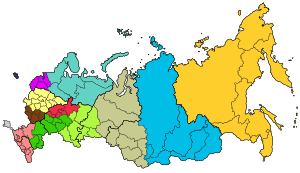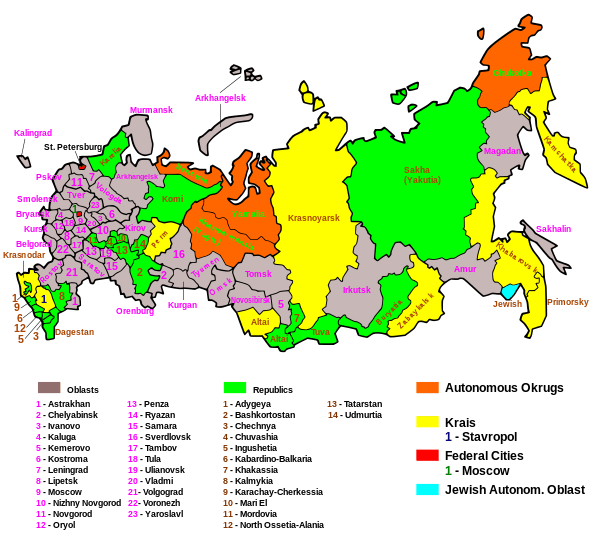Subdivisions of Russia
 |
| This article is part of a series on the politics and government of Russia |
Russia is divided into several types and levels of subdivisions.
Federal subjects
Since March 18, 2014, the Russian Federation consisted of eighty-five federal subjects that are constituent members of the Federation.[1] However, two of these federal subjects—the Republic of Crimea and the federal city of Sevastopol—are internationally recognized as part of Ukraine. All federal subjects are of equal federal rights in the sense that they have equal representation—two delegates each—in the Federation Council (upper house of the Federal Assembly). They do, however, differ in the degree of autonomy they enjoy.
There are 6 types of federal subjects—22 republics, 9 krais, 46 oblasts, 3 federal cities, 1 autonomous oblast, and 4 autonomous okrugs.
Autonomous okrugs are the only ones that have a peculiar status of being federal subjects in their own right, yet at the same time they are considered to be administrative divisions of other federal subjects (with Chukotka Autonomous Okrug being the only exception).
2014 Crimean crisis
On March 18, 2014, as a part of the 2014 Crimean crisis events and following the establishment of the Republic of Crimea (an independent entity recognized only by Russia), a treaty was signed between Russia and the Republic of Crimea incorporating the Republic of Crimea and the City of Sevastopol as the constituent members of the Russian Federation.[2] According to the Treaty, the Republic of Crimea is accepted as a federal subject with the status of a republic while the City of Sevastopol has received federal city status.[2] Neither the Republic of Crimea nor the city of Sevastopol are politically recognized as parts of Russia by most countries.[3]
Administrative divisions
Prior to the adoption of the 1993 Constitution of Russia, the administrative-territorial structure of Russia was regulated by the Decree of the Presidium of the Supreme Soviet of the RSFSR of August 17, 1982 "On the Procedures of Dealing with the Matters of the Administrative-Territorial Structure of the RSFSR".[4] The 1993 Constitution, however, did not identify the matters of the administrative-territorial divisions as the responsibility of the federal government nor as the joint responsibility of the federal government and the subjects. This was interpreted by the governments of the federal subjects as a sign that the matters of the administrative-territorial divisions became solely the responsibility of the federal subjects.[4] As a result, the modern administrative-territorial structures of the federal subjects vary significantly from one federal subject to another. While the implementation details may be considerably different, in general, however, the following types of high-level administrative divisions are recognized:
- administrative districts (raions)
- cities/towns and urban-type settlements of federal subject significance
- closed administrative-territorial formations
Autonomous okrugs and okrugs are intermediary units of administrative divisions, which include some of the federal subject's districts and cities/towns/urban-type settlements of federal subject significance.
- Autonomous okrugs, while being under the jurisdiction of another federal subject, are still constitutionally recognized as federal subjects on their own right. Chukotka Autonomous Okrug is an exception in that it is not administratively subordinated to any other federal subject of Russia.
- Okrugs are usually former autonomous okrugs that lost their federal subject status due to a merger with another federal subject.
Typical lower-level administrative divisions include:
- selsoviets (rural councils)
- towns and urban-type settlements of the administrative district significance
- city districts
Municipal divisions
In the course of the Russian municipal reform of 2004–2005, all federal subjects of Russia were to streamline the structures of local self-government, which is guaranteed by the Constitution of Russia. The reform mandated that each federal subject was to have a unified structure of the municipal government bodies by January 1, 2005, and a law enforcing the reform provisions went in effect on January 1, 2006. According to the law, the units of the municipal division (called "municipal formations") are as follows:[5]
- Municipal district, a group of urban and rural settlements, often along with the inter-settlement territories. In practice, municipal districts are usually formed within the boundaries of existing administrative districts (raions).
- Urban settlement, a city/town or an urban-type settlement, possibly together with adjacent rural and/or urban localities
- Rural settlement, one or several rural localities
- Urban okrug, an urban settlement not incorporated into a municipal district. In practice, urban okrugs are usually formed within the boundaries of existing cities of federal subject significance.
- Intra-urban territory (intra-urban municipal formation) of a federal city, a part of a federal city's territory. In Moscow, these are called municipal formations (which correspond to districts); in St. Petersburg—municipal okrugs, towns, and settlements. In Sevastopol (located on the Crimean Peninsula, which is a territory disputed between Russia and Ukraine), they are known as municipal okrugs and a town.[6]
Territories not included as a part of municipal formations are known as inter-settlement territories.
The Federal Law was amended on May 27, 2014 to include new types of municipal divisions:[7]
- Urban okrug with intra-urban divisions, an urban okrug divided into intra-urban districts at the lower level of the municipal hierarchy
- Intra-urban district, a municipal formation within an urban okrug with intra-urban divisions. This municipal formation type would typically be established within the borders of existing city districts (i.e., the administrative divisions in some of the cities of federal subject significance).
In June 2014, Chelyabinsky Urban Okrug became the first urban okrug to implement intra-urban divisions.[8]
Other types of subdivisions
Federal districts

All of the federal subjects are grouped into nine federal districts,[9] each administered by an envoy appointed by the President of Russia. Federal districts' envoys serve as liaisons between the federal subjects and the federal government and are primarily responsible for overseeing the compliance of the federal subjects with the federal laws.
Economic regions

For economic and statistical purposes the federal subjects are grouped into twelve economic regions.[10] Economic regions and their parts sharing common economic trends are in turn grouped into economic zones and macrozones.
Military districts

In order for the Armed Forces to provide an efficient management of military units, their training, and other operational activities, the federal subjects are grouped into five military districts.[11] Each military district operates under the command of the district headquarters, headed by the district commander, and is subordinated to the General Staff of the Armed Forces of the Russian Federation.
See also
- History of the administrative division of Russia
- List of federal subjects of Russia by area
- List of federal subjects of Russia by population
- Types of inhabited localities in Russia
- Republics of the Soviet Union
References
- ↑ Constitution, Article 65
- 1 2 Kremlin.ru. "Договор между Российской Федерацией и Республикой Крым о принятии в Российскую Федерацию Республики Крым и образовании в составе Российской Федерации новых субъектов" ("Treaty Between the Russian Federation and the Republic of Crimea on Ascension to the Russian Federation of the Republic of Crimea and on Establishment of New Subjects Within the Russian Federation") (Russian)
- ↑ "Putin signs Crimea treaty, will not seize other Ukraine regions", Reuters, 18 March 2014.
- 1 2 "Энциклопедический словарь конституционного права". Статья "Административно-территориальное устройство". Сост. А. А. Избранов. — Мн.: Изд. В.М. Суров, 2001.
- ↑ Государственная Дума Российской Федерации. Федеральный Закон №131-ФЗ от 6 октября 2003 г. «Об общих принципах организации местного самоуправления в Российской Федерации», в ред. Федерального Закона №243-ФЗ от 28 сентября 2010 г. (State Duma of the Russian Federation. Federal Law #131-FZ of October 6, 2003 On the General Principles of Organization of the Local Self-Government in the Russian Federation, as amended by the Federal Law #243-FZ of September 28, 2010. ).
- ↑ Law #17-ZS
- ↑ Федеральный Закон №136-ФЗ от 27 мая 2014 г. «О внесении изменений в статью 26.3 Федерального Закона "Об общих принципах организации законодательных (представительных) и исполнительных органов государственной власти субъектов Российской Федерации" и Федеральный Закон "Об общих принципах организации местного самоуправления в Российской Федерации"». Вступил в силу со дня официального опубликования. Опубликован: Официальный интернет-портал правовой информации http://www.pravo.gov.ru, 27 мая 2014 г. (Federal Law #136-FZ of May 27, 2014 On Amending Article 26.3 of the Federal Law "On the General Principles of Organization of Legislative (Representative) and Executive Bodies of State Power in the Subjects of the Russian Federation" and the Federal Law "On the General Principles of Organization of the Local Self-Government in the Russian Federation". Effective as of the day of the official publication.).
- ↑ Законодательное Собрание Челябинской области. Закон №706-ЗО от 10 июня 2014 г. «О статусе и границах Челябинского городского округа и внутригородских районов в его составе». Вступил в силу со дня официального опубликования. Опубликован: "Южноуральская панорама", №87 (спецвыпуск №24), 14 июня 2014 г. (Legislative Assembly of Chelyabinsk Oblast. Law #706-ZO of June 10, 2014 On the Status and Borders of Chelyabinsky Urban Okrug and the City Districts It Comprises. Effective as of the day of the official publication.).
- ↑ Президент Российской Федерации. Указ №849 от 13 мая 2000 г. «О полномочном представителе Президента Российской Федерации в федеральном округе». Вступил в силу 13 мая 2000 г. Опубликован: "Собрание законодательства РФ", №20, ст. 2112, 15 мая 2000 г. (President of the Russian Federation. Decree #849 of May 13, 2000 On the Plenipotentiary Representative of the President of the Russian Federation in a Federal District. Effective as of May 13, 2000.).
- ↑ "Общероссийский классификатор экономических регионов" (ОК 024-95) введённый 1 января 1997 г., в ред. Изменения № 05/2001. Секция II. Экономические районы (Russian Classification of Economic Regions (OK 024-95) of January 1, 1997 as amended by the Amendments #1/1998 through #5/2001. Section II. Economic Regions)
- ↑ Президент Российской Федерации. Указ №900 от 27 июль 1998 г. «О военно-административном делении Российской Федерации», в ред. Указа №1144 от 20 сентябрь 2010 г. Вступил в силу 27 июль 1998 г.. (President of the Russian Federation. Decree #900 of July 27, 1998 On Military Administrative Division of the Russian Federation, as amended by the Decree #1144 of September 20, 2010. Effective as of July 27, 1998.).
Sources
- 12 декабря 1993 г. «Конституция Российской Федерации», в ред. Федерального конституционного закона №7-ФКЗ от 30 декабря 2008 г. Вступил в силу со дня официального опубликования. Опубликован: "Российская газета", №237, 25 декабря 1993 г. (December 12, 1993 Constitution of the Russian Federation, as amended by the Federal Constitutional Law #7-FKZ of December 30, 2008. Effective as of the official publication date.).
- Законодательное Собрание города Севастополя. Закон №17-ЗС от 3 июня 2014 г. «Об установлении границ и статусе муниципальных образований в городе Севастополе». Вступил в силу через 10 дней со дня официального опубликования. (Legislative Assembly of the City of Sevastopol. Law #17-ZS of June 3, 2014 On Establishing the Borders and the Status of the Municipal Formations in the City of Sevastopol. Effective as of the day which is 10 days after the day of the official publication.).
